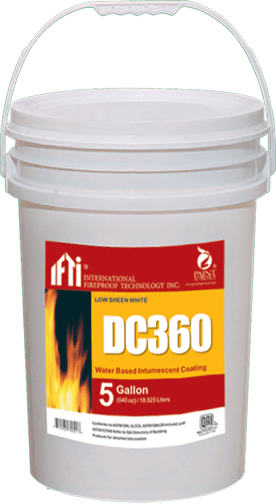Table of Contents
What is DC360?
DC360 is a surface coating used for fire protection. Specifically, it is a water-based intumescent coating. DC360 swells in response to heat exposure and acts as passive fire protection.

Key features of DC360
The main feature of DC360 is fire protection. DC360 coating reduces the flammability and smoke development of construction materials. For example, plywood, gypsum, and lumber can be protected with DC360.
The coating can be used in interior spaces, including attics, which reduces the need for a fire suppression system. Insurance companies are starting to recommend intumescent coatings because they reduce the need for other fireproofing systems like sprinklers that can cause water damage.
What standards does DC360 meet?
DC360 meets several standards, such as ASTM E84 and ASTM E2768.
ASTM E84 and ASTM E2768 are similar tests. ASTM E84 measures and evaluates the flame spread and smoke development of construction materials. ASTM E84 is conducted using a Steiner tunnel, where a sample of the material in question is exposed to a flame and the flame spread and smoke production are measured over 10 minutes.
ASTM E2768 is very similar to the ASTM E84 test, except it is measured over 30 minutes. ASTM E2768 is most relevant where materials need extended periods of fire resistance.
For both of these standards, DC360 coating will get you a passing, Class A rating. A Class A rating requires a minimum of 24 for a Flame Spread Index and a Smoke Development Rating of 450 or lower.
| Class | Flame Spread Index | Smoke Development Rating |
| Class A or 1 | 0 – 25 | 450 maximum |
| Class B or 2 | 26 – 75 | 450 maximum |
| Class C or 3 | 76-200 | 450 maximum |
What equipment can you use to apply DC360?
You can use several types of equipment to apply DC360. These include spray, tip, reduction, roller, and a brush.
An airless sprayer is the recommended method to apply DC360. With sprayers, you can easily achieve an even coating. However, in areas that are difficult to reach, a sprayer may not be practical. In those areas, you may opt for a brush, roller, or some other applicator.
How to use DC360
Prepare Your Surface
Before applying DC360, you should make sure your surface is prepared. First, the surface must be clean, dry, and firm. It should be free of any dust, dirt, wax, grease, oil, or mildew.
It should not contain any loose flaky paint, rust, or efflorescence (e.g., deposit of salts). In other words, the surface should be smooth and dry.
Before applying the DC360 to a previously painted surface, you should check for interactions. For example, you could test the previous paint and the coating in a small area. If interactions occur, you will need a primer before applying DC360 to your surface.
Application
You can apply DC360 in multiple coating layers. You may use a brush, roller, airless sprayer, or some combination of these applicators.
The temperature should be above 50ºF or 10ºC when applying the coating. As mentioned above, the airless sprayer is the best method for consistent application. However, in some areas, you may need to use a brush or roller. When using a brush or roller, it should be fully loaded for even application.
Allow the DC360 Coating to Dry
Once you have applied a layer of DC360, you should wait for it to dry. Each coating layer must be fully dry before applying an additional layer.
Drying time is affected by many factors, including temperature, humidity, application thickness, and method of application. To speed the drying process, you may use fans to better circulate air.
Measure the Coating Thickness
The coating thickness is important for meeting fire safety standards. To measure the thickness, you can use a wet film thickness gauge. This gauge measures the thickness using a comb. The teeth of the comb that are inserted into the coating measure the coating thickness.
The dry film thickness determines the coverage rate. There is no specific coverage rate applicable to all assemblies. Generally, the ratio of wet thickness to fry thickness is 1.5 to 1.
Alternatives Intumescent Coatings
In addition to DC360 coating, several other options are available. Each has its advantages and disadvantages. We’ll discuss them below.
- Fireguard E-84 is a water-based, intumescent coating for fire protection safety. It is designed to work on gypsum and plywood. Fireguard E-84 meets several standards, including Class A for ASTM E-84, ASTM 2768, and ASTM E-119. After 4-5 days of drying time, the color finish for this coating is white, and the texture is smooth.
- Firetex FX5090 is considered a thin-film, water-based, intumescent paint. It provides similar fire protection as Fireguard E-84 and meets Class A standards for surface burning tests (e.g., ASTM E-84). The drying time is relatively short, requiring a minimum of 4 hours to recoat and 90 minutes to touch. Like Fireguard E-84, the finish color is white, and the surface texture is flat.
- FireFree88 is a premium, but cost-efficient, intumescent paint. Because such a thin layer is needed with FireFree88, the cost is lower per usage as compared to its competitors. FireFree88 also meets multiple fire safety standards, such as ASTM E119 and ASTM E-84. It can be used on wood, gypsum, concrete, aluminum, and several other materials. The finish color is white and the texture is flat.